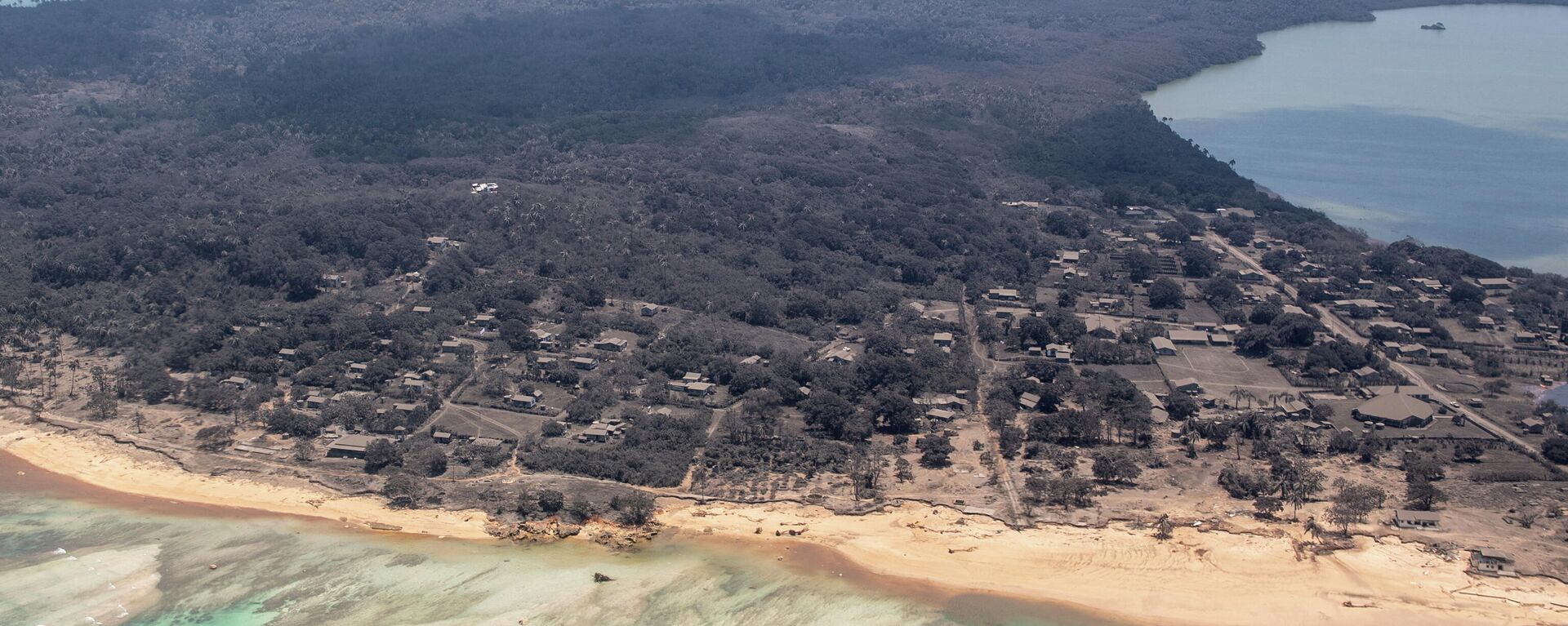https://sputnikglobe.com/20220130/mysterious-acoustic-gravity-waves-caused-by-tonga-volcano-eruption-baffle-scientists---1092623821.html
Mysterious Acoustic-Gravity Waves Caused by Tonga Volcano Eruption Baffle Scientists
Mysterious Acoustic-Gravity Waves Caused by Tonga Volcano Eruption Baffle Scientists
Sputnik International
The 14 January eruption of the Hunga Tonga-Hunga Ha'apai Tong volcano sent ash 100,000 feet (about 30 kilometres) high into the sky, with the effects felt as... 30.01.2022, Sputnik International
2022-01-30T17:52+0000
2022-01-30T17:52+0000
2022-01-30T17:52+0000
volcano
tonga
eruption
volcanic ash
aftermath
https://cdn1.img.sputnikglobe.com/img/07e6/01/1e/1092622956_0:161:3068:1887_1920x0_80_0_0_7677bdbb40f0e531da504b59ac45cfdc.jpg
This month’s eruption of the Hunga Tonga-Hunga Ha'apai volcano caused mysterious concentric ripples in the atmosphere which had never been seen before.Although AGW waves are not unknown to researchers, never before have they been so distinctively registered during volcanic eruptions. Powerful AGWs are typically associated with earthquakes and tsunamis, as well as some man-made events such as rocket launches or explosions.Smaller AGWs arise due to a variety of natural phenomena, including the movements of atmospheric fronts, thunderstorms, geomagnetic storms, solar flares, and even daily fluctuations in the atmosphere.Sergei Pulinets from the Space Research Institute of the Russian Academy of Sciences told Sputnik that even though on the whole “there is nothing unusual” about AGWs, the waves that were generated by the 14 January Tonga volcano eruption were another cup of tea.Researcher Diego Aliaga at the University of Helsinki has meanwhile tweeted about “amazing” fallout from the Tonga eruption, adding that after seven days of the natural phenomenon, “shock wave continues to circle the planet (10 times!) and can still be detected in the infrared by geostationary satellites such as GOES16 and GOES17”.The colossal detonation, as well as the massive underwater aftermath and the subsequent tsunami generated a whole spectrum of waves spreading both in the lower and upper layers of the atmosphere. In addition to the AGWs, Lamb waves as well as electromagnetic and infrasonic ones emerged in the ionosphere. According to researchers, all this testifies to the uniqueness of the fallout from the Tonga volcano eruption.NASA experts estimated the power of the eruption at 10 megatons of TNT, 500 times stronger than the explosion of the atomic bomb dropped by the Americans on the Japanese city of Hiroshima in August 1945.Tonga's government, in turn, said that the eruption and the tsunami had caused an "unprecedented disaster" for the island nation, which claimed the lives of at least three people. Also, the infrastructure and housing on Mango and Atata islands, which were home to 150 residents, were destroyed in the eruption.
https://sputnikglobe.com/20220127/usgs-62-magnitude-quake-strikes-pangai-tonga-1092547322.html
tonga
Sputnik International
feedback@sputniknews.com
+74956456601
MIA „Rossiya Segodnya“
2022
Oleg Burunov
https://cdn1.img.sputnikglobe.com/img/07e4/09/0b/1080424846_0:0:2048:2048_100x100_80_0_0_3d7b461f8a98586fa3fe739930816aea.jpg
Oleg Burunov
https://cdn1.img.sputnikglobe.com/img/07e4/09/0b/1080424846_0:0:2048:2048_100x100_80_0_0_3d7b461f8a98586fa3fe739930816aea.jpg
News
en_EN
Sputnik International
feedback@sputniknews.com
+74956456601
MIA „Rossiya Segodnya“
Sputnik International
feedback@sputniknews.com
+74956456601
MIA „Rossiya Segodnya“
Oleg Burunov
https://cdn1.img.sputnikglobe.com/img/07e4/09/0b/1080424846_0:0:2048:2048_100x100_80_0_0_3d7b461f8a98586fa3fe739930816aea.jpg
volcano, tonga, eruption, volcanic ash, aftermath
volcano, tonga, eruption, volcanic ash, aftermath
Mysterious Acoustic-Gravity Waves Caused by Tonga Volcano Eruption Baffle Scientists
The 14 January eruption of the Hunga Tonga-Hunga Ha'apai Tong volcano sent ash 100,000 feet (about 30 kilometres) high into the sky, with the effects felt as far away as the US West Coast.
This month’s eruption of
the Hunga Tonga-Hunga Ha'apai volcano caused mysterious concentric ripples in the atmosphere which had never been seen before.
Scientists believe that the ripples were caused by so-called acoustic-gravity waves (AGWs), but not everything is as simple as it may seem at first glance.
Although AGW waves are not unknown to researchers, never before have they been so distinctively registered during volcanic eruptions. Powerful AGWs are typically associated with earthquakes and tsunamis, as well as some man-made events such as rocket launches or explosions.
Smaller AGWs arise due to a variety of natural phenomena, including the movements of atmospheric fronts, thunderstorms, geomagnetic storms, solar flares, and even daily fluctuations in the atmosphere.
Sergei Pulinets from the Space Research Institute of the Russian Academy of Sciences told Sputnik that even though on the whole “there is nothing unusual” about AGWs, the waves that were generated by the 14 January Tonga volcano eruption were another cup of tea.
“The matter is that the eruption took place under water, which was followed by the AGWs being mixed with an atmospheric wave generated by a powerful ejection of ash. One more wave was caused by a tsunami, so the different scales created a wide pattern of fluctuations at different frequencies. And given the fact that Tonga is an isolated island located in the middle of the ocean, a circular wave rather than a reflected one emerged, which is not the case with coastal eruptions”, Pulinets explained.
Researcher Diego Aliaga at the University of Helsinki has meanwhile tweeted about “amazing” fallout from the Tonga eruption, adding that after seven days of the natural phenomenon, “shock wave continues to circle the planet (10 times!) and can still be detected in the infrared by geostationary satellites such as GOES16 and GOES17”.
The colossal detonation, as well as the massive underwater aftermath and the subsequent tsunami generated a whole spectrum of waves spreading both in the lower and upper layers of the atmosphere. In addition to the AGWs, Lamb waves as well as electromagnetic and infrasonic ones emerged in the ionosphere. According to researchers, all this testifies to the uniqueness of the fallout from the Tonga volcano eruption.

27 January 2022, 07:12 GMT
NASA experts estimated the power of the eruption at 10 megatons of TNT, 500 times stronger than the explosion of the atomic bomb dropped by the Americans on the Japanese city of Hiroshima in August 1945.
Tonga's government, in turn, said that the eruption and the tsunami had caused an "unprecedented disaster" for the island nation, which claimed the lives of at least three people. Also, the infrastructure and housing on Mango and Atata islands, which were home to 150 residents, were destroyed in the eruption.




